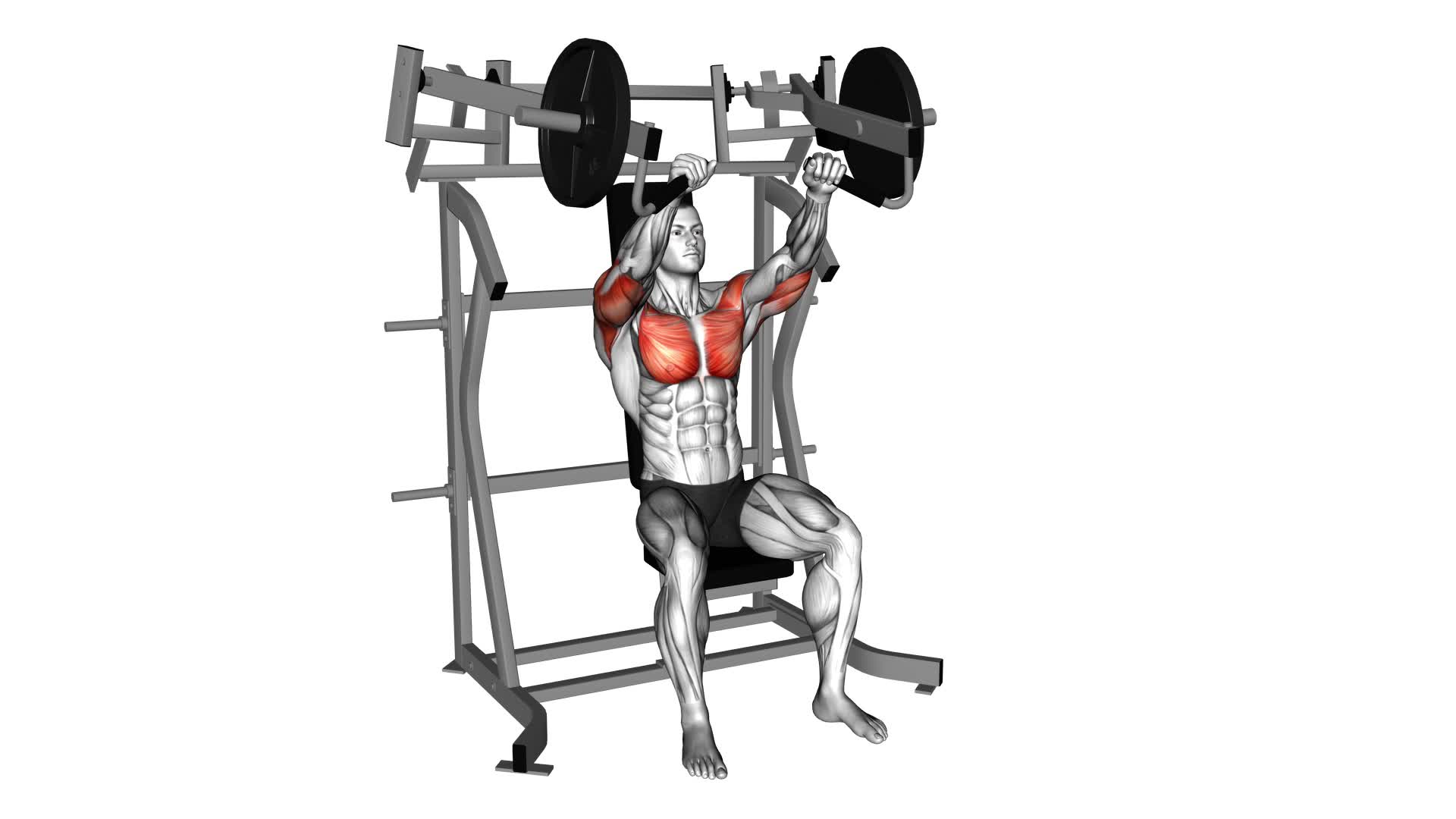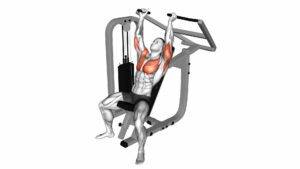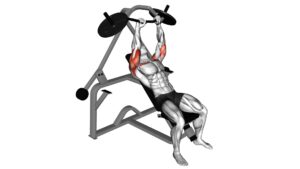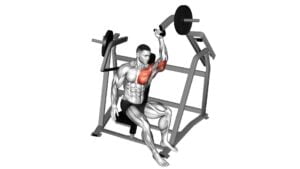Lever Incline Chest Press – Video Exercise Guide & Tips

Get ready to amp up your chest workout with the lever incline chest press! This exercise is all about targeting and strengthening your chest muscles.
Watch This Exercise Video
In this video exercise guide, we'll show you the proper setup, correct body positioning, and step-by-step execution. Plus, we'll share common mistakes to avoid and give you tips for progression and variation.
So grab your equipment and get ready to feel the burn in your chest like never before!
Key Takeaways
- Proper setup and equipment are essential for performing the lever incline chest press correctly.
- Correct body positioning, including sitting with back against the bench and aligning the body correctly, is crucial for engaging the targeted muscles.
- The step-by-step execution involves sitting on the incline bench, grabbing the lever handles with an overhand grip, and slowly bringing them back towards the chest while maintaining control and engaging the chest muscles.
- It is important to avoid common mistakes such as using excessive weight, not maintaining proper technique, and not targeting the upper chest muscles effectively.
Proper Setup and Equipment
To ensure proper form and maximize the effectiveness of your lever incline chest press, you need to set up the equipment correctly. The lever incline chest press is a great exercise for targeting your upper chest muscles and can provide a variety of benefits. By adjusting the incline bench to a 45-degree angle, you can isolate the upper chest muscles more effectively than with a flat bench press. This exercise also engages the shoulders and triceps to a lesser extent.
When setting up the equipment, make sure the bench is positioned at the desired angle and securely locked in place. Adjust the lever arms to a height that allows you to comfortably grip the handles. The handles should be at chest level when you're seated on the bench. Ensure that the weight stack is set to an appropriate resistance for your fitness level.
There are also variations and modifications of the lever incline chest press that you can incorporate into your routine. For example, you can use dumbbells instead of the lever arms to increase the challenge and engage more stabilizer muscles. Alternatively, you can perform a single-arm incline press to further isolate each side of the chest. Experiment with different variations to keep your workouts challenging and prevent plateaus in your progress.
Correct Body Positioning
When positioning your body for the lever incline chest press, ensure that you're seated on the bench with your feet planted firmly on the ground. Proper body alignment is crucial for maximizing the effectiveness of this exercise and minimizing the risk of injury. Here are some key points to keep in mind:
- Sit with your back against the bench, maintaining a neutral spine. This helps to engage your core muscles and stabilize your body throughout the movement.
- Position your feet shoulder-width apart, ensuring that they're flat on the ground. This provides a stable base of support and allows for better force transfer during the exercise.
- Keep your knees bent at a 90-degree angle. This helps to maintain stability and prevent excessive strain on your lower back.
By aligning your body correctly, you ensure that the targeted muscles, such as the chest, shoulders, and triceps, are properly engaged. This allows for better muscle activation and overall effectiveness of the exercise.
Now that you have established the correct body positioning, let's move on to the step-by-step execution of the lever incline chest press.
Step-by-Step Execution
Now let's dive into the step-by-step execution of the lever incline chest press.
First, you'll be shown the proper form demonstration to ensure you're performing the exercise correctly.
Next, we'll highlight common mistakes to avoid, helping you maximize the effectiveness of your workout.
Proper Form Demonstration
Follow these steps to properly execute the Lever Incline Chest Press exercise:
- Sit on an incline bench with your feet flat on the floor.
- Adjust the lever handles so that they're aligned with your chest muscles.
- Grab the handles with an overhand grip and push them away from your body until your arms are fully extended.
Slowly bring the handles back towards your chest, keeping your elbows slightly bent.
- Make sure to maintain control throughout the movement, engaging your chest muscles.
- Keep your back flat against the bench and avoid arching or lifting your hips.
Breathe out as you push the handles away from your body and breathe in as you bring them back towards your chest.
- Repeat for the desired number of repetitions.
By following these steps, you can ensure proper form and effectively target your chest muscles.
Now, let's move on to the next section and discuss common mistakes to avoid.
Common Mistakes to Avoid
To avoid common mistakes during the step-by-step execution of the Lever Incline Chest Press, ensure that you maintain control and engage your chest muscles throughout the movement. One common mistake to avoid is using excessive weight that compromises your form. It's important to select a weight that allows you to perform the exercise with proper technique.
Another mistake is neglecting the full range of motion. Make sure to lower the lever handles until your upper arms are parallel to the floor, and then push them back up until your elbows are extended. By completing the full range of motion, you maximize the benefits of the incline press, which include targeting the upper chest muscles and improving upper body strength.
Benefits of Incline Press
To maximize the benefits of the incline press, you should ensure that you engage your chest muscles and maintain control throughout the movement.
Here are the key benefits of incline press:
- Muscle Activation: The incline press primarily targets the upper chest muscles, also known as the pectoralis major. By performing this exercise, you can effectively activate and strengthen these muscles, enhancing the overall appearance and strength of your chest.
- Strength Gains: Incline press is an excellent exercise for building upper body strength. It engages not only the chest muscles but also the shoulders and triceps. By consistently incorporating incline press into your workout routine, you can experience significant gains in upper body strength, allowing you to lift heavier weights and perform other exercises with greater ease.
- Variation: Adding incline press to your chest workout routine adds variety and helps prevent muscle adaptation. By changing the angle of the bench, you challenge your muscles in a different way, stimulating new muscle growth and preventing plateaus.
Incorporating incline press into your workout can lead to improved muscle activation, increased strength gains, and added variation to your routine. So, give it a try and reap the benefits!
Targeted Muscles and Benefits
The Lever Incline Chest Press targets the chest muscles and offers several benefits. This exercise is a variation of the incline press, which is known for its ability to activate the upper chest muscles. By adjusting the incline angle of the bench, you can specifically target different areas of the chest. The Lever Incline Chest Press is an effective way to activate and strengthen the pectoralis major and pectoralis minor muscles.
Engaging these muscles helps to improve upper body strength and increase overall muscle definition in the chest. Additionally, the Lever Incline Chest Press also engages the anterior deltoids and triceps, providing a comprehensive upper body workout.
By incorporating the Lever Incline Chest Press into your routine, you can enhance your chest development and improve your overall upper body strength. This exercise is particularly beneficial for those aiming to build a well-rounded physique or improve their athletic performance.
Transitioning into the next section about common mistakes to avoid, it's important to ensure proper form and technique when performing the Lever Incline Chest Press to maximize its benefits and minimize the risk of injury.
Common Mistakes to Avoid
To perform the lever incline chest press correctly, it's important to maintain proper form throughout the exercise. Avoid the mistake of using excessive weight, as this can lead to poor form and potential injuries.
Remember to focus on your breathing technique, exhaling during the exertion phase and inhaling during the release phase for optimal performance.
Proper Form Importance
Maintaining proper form is crucial for maximizing the effectiveness of the lever incline chest press exercise and avoiding common mistakes. By understanding the importance of warm up and the benefits of proper form, you can greatly enhance your workout experience.
Here are three key reasons why proper form is essential:
- Injury Prevention: Performing the exercise with proper form reduces the risk of injury. It ensures that the targeted muscles are engaged while minimizing strain on other joints or muscles.
- Muscle Activation: Proper form ensures that the intended muscles are being targeted effectively, leading to better muscle activation and development.
- Workout Efficiency: When you maintain proper form, you optimize the movement and engage the targeted muscles more efficiently, resulting in a more effective and productive workout.
Avoiding Excessive Weight
To avoid excessive weight during the lever incline chest press exercise, focus on using a weight that challenges you without compromising your form or risking injury. It's important to use proper progression techniques to gradually increase the weight over time, rather than starting with a weight that's too heavy.
This allows your muscles to adapt and grow stronger without putting too much strain on them. Avoiding injuries is crucial in any exercise, and using excessive weight can increase the risk of strains, sprains, and other injuries.
Remember to listen to your body and pay attention to any pain or discomfort. If you experience any, reduce the weight or seek guidance from a fitness professional. Prioritizing safety and proper technique will help you achieve better results in the long run.
Breathing Technique Tips
Breathe deeply and consistently throughout the lever incline chest press exercise to optimize your performance and avoid common mistakes. Proper breathing technique not only benefits your overall workout, but also helps maintain a steady rhythm and control your movements.
Here are some tips to improve your breathing technique during the lever incline chest press:
- Inhale deeply through your nose as you lower the lever towards your chest.
- Exhale forcefully through your mouth as you push the lever away from your chest.
- Avoid holding your breath or shallow breathing, as it can limit your oxygen intake and decrease your strength.
Tips for Progression and Variation
When progressing and varying your Lever Incline Chest Press workout, it's important to prioritize proper form and technique. To progress effectively, start by increasing the weight gradually. This will challenge your muscles and help them grow stronger over time. It's recommended to increase the weight by small increments, such as 2.5-5 pounds, to avoid straining yourself.
Another important tip for progression is to focus on increasing the number of repetitions or sets. You can start with a comfortable number and gradually work your way up as you get stronger. This will help improve your endurance and overall fitness level.
In terms of variation, there are several ideas to keep your Lever Incline Chest Press routine interesting and effective. One option is to change the angle of the incline bench. By adjusting the bench to different angles, you can target different areas of your chest muscles.
Another variation idea is to incorporate supersets or drop sets into your workout. Supersets involve performing two exercises back-to-back without resting, while drop sets involve decreasing the weight after each set. These techniques can help increase the intensity of your workout and promote muscle growth.
Frequently Asked Questions
How Many Sets and Reps Should I Do When Performing the Lever Incline Chest Press?
When performing the lever incline chest press, it's important to choose the right number of sets and reps to maximize your workout.
This exercise is one of the incline chest press variations that you can do using lever machines.
The number of sets and reps will depend on your fitness level and goals. It's recommended to start with 2-3 sets of 8-12 reps and gradually increase the intensity as you progress.
Lever machines offer benefits such as stability and targeted muscle engagement.
Can I Use Dumbbells Instead of a Lever Machine for the Incline Chest Press Exercise?
Yes, you can definitely use dumbbells instead of a lever machine for the incline chest press exercise. Dumbbell variations of the incline chest press offer a great alternative and can be just as effective in targeting your chest muscles.
However, using a lever machine for the incline chest press has its own benefits. It provides stability and allows for a controlled range of motion, helping to isolate and activate the chest muscles more effectively.
Is the Lever Incline Chest Press Suitable for Beginners?
Yes, the lever incline chest press is suitable for beginners. It offers several benefits for muscle growth, such as targeting your chest, shoulders, and triceps.
However, it's crucial to maintain proper form and technique to maximize results and prevent injuries. Focus on keeping your back flat against the bench, using controlled movements, and breathing properly throughout the exercise.
Gradually increase the weight as you become more comfortable and confident with the exercise.
Can I Perform the Lever Incline Chest Press if I Have a Shoulder Injury?
If you have a shoulder injury, it's important to consult with a healthcare professional or a certified trainer to determine the best modifications for your specific injury.
You may need to modify the lever incline chest press exercise.
The lever incline chest press is known for its benefits in improving upper body strength, particularly in the chest, shoulders, and triceps.
However, it's crucial to prioritize your shoulder's recovery and not push yourself beyond what's comfortable or safe.
What Other Exercises Can I Incorporate Into My Workout Routine to Target the Same Muscles as the Lever Incline Chest Press?
Looking to target the same muscles as the lever incline chest press? Consider incorporating the incline dumbbell press and cable flys into your workout routine.
These exercises engage the chest muscles, just like the lever incline chest press. The incline dumbbell press involves lifting dumbbells while lying on an incline bench, while cable flys utilize cables to perform a pressing motion.
Both exercises can help you achieve a strong and defined chest.
Conclusion
In conclusion, the lever incline chest press is an effective exercise for targeting the chest muscles. By following the proper setup and equipment, correct body positioning, and step-by-step execution, you can maximize the benefits of this exercise.
It's important to avoid common mistakes and progress gradually for optimal results. Adding variation to your workout routine will keep your muscles challenged and help you achieve your fitness goals.

Author
Years ago, the spark of my life’s passion ignited in my mind the moment I stepped into the local gym for the first time. The inaugural bead of perspiration, the initial endeavor, the very first surge of endorphins, and a sense of pride that washed over me post-workout marked the beginning of my deep-seated interest in strength sports, fitness, and sports nutrition. This very curiosity blossomed rapidly into a profound fascination, propelling me to earn a Master’s degree in Physical Education from the Academy of Physical Education in Krakow, followed by a Sports Manager diploma from the Jagiellonian University. My journey of growth led me to gain more specialized qualifications, such as being a certified personal trainer with a focus on sports dietetics, a lifeguard, and an instructor for wellness and corrective gymnastics. Theoretical knowledge paired seamlessly with practical experience, reinforcing my belief that the transformation of individuals under my guidance was also a reflection of my personal growth. This belief holds true even today. Each day, I strive to push the boundaries and explore new realms. These realms gently elevate me to greater heights. The unique combination of passion for my field and the continuous quest for growth fuels my drive to break new ground.



